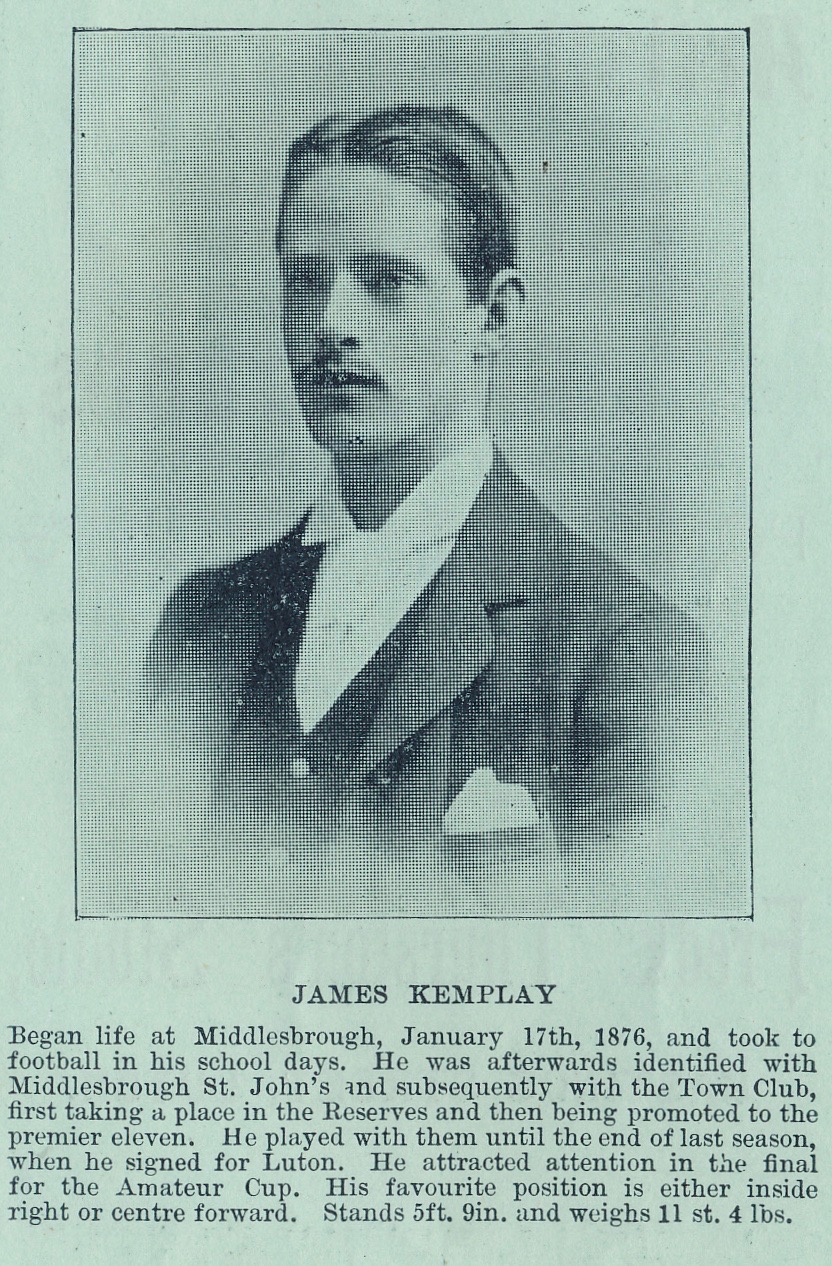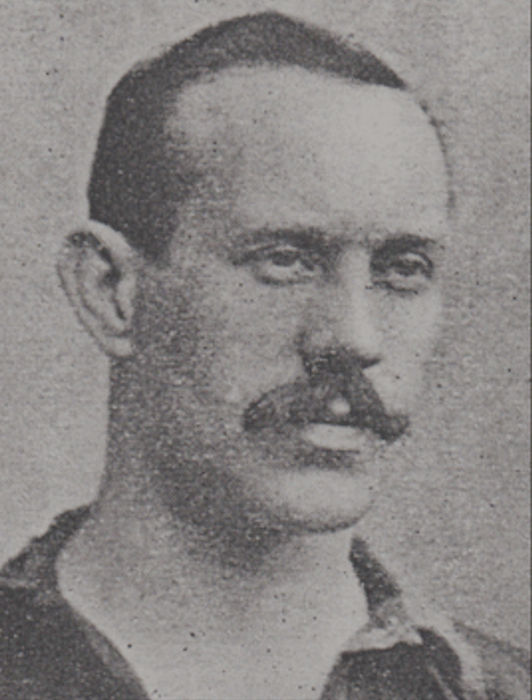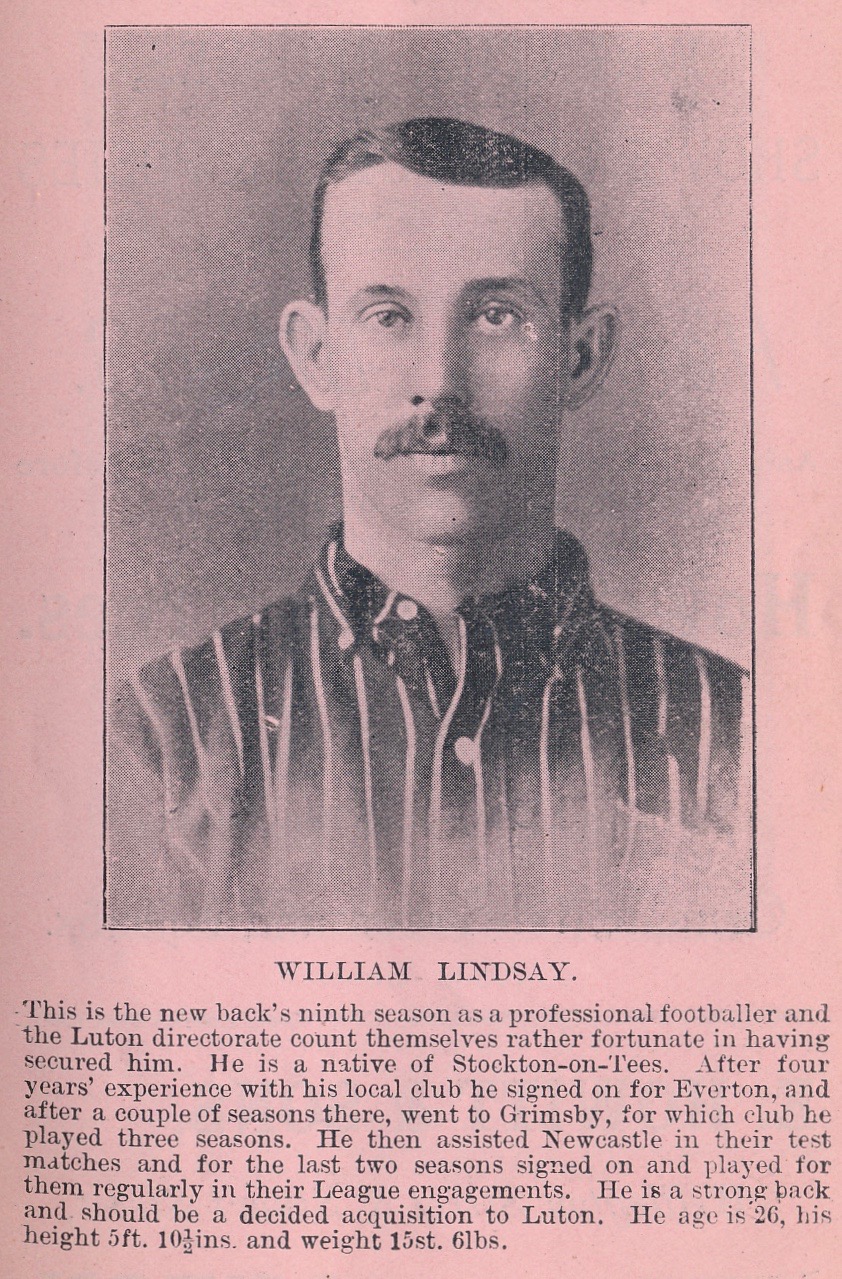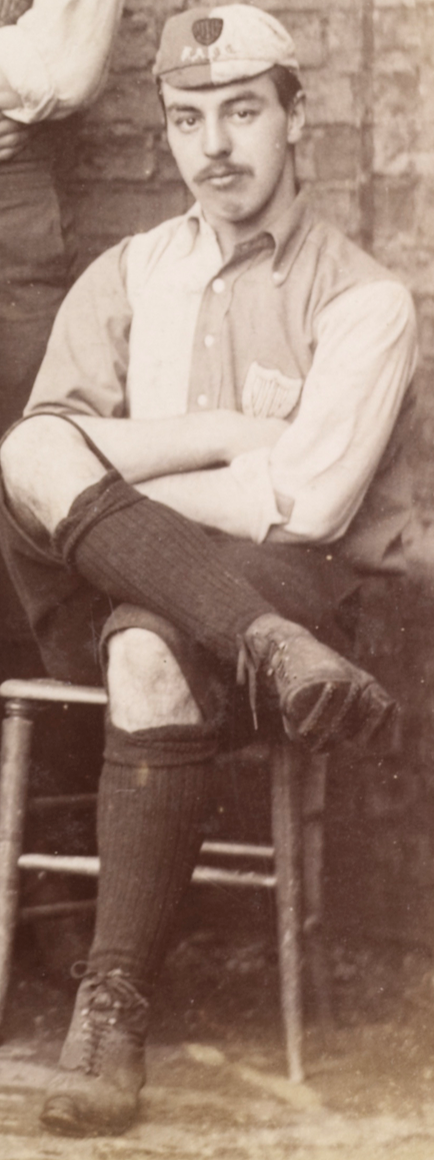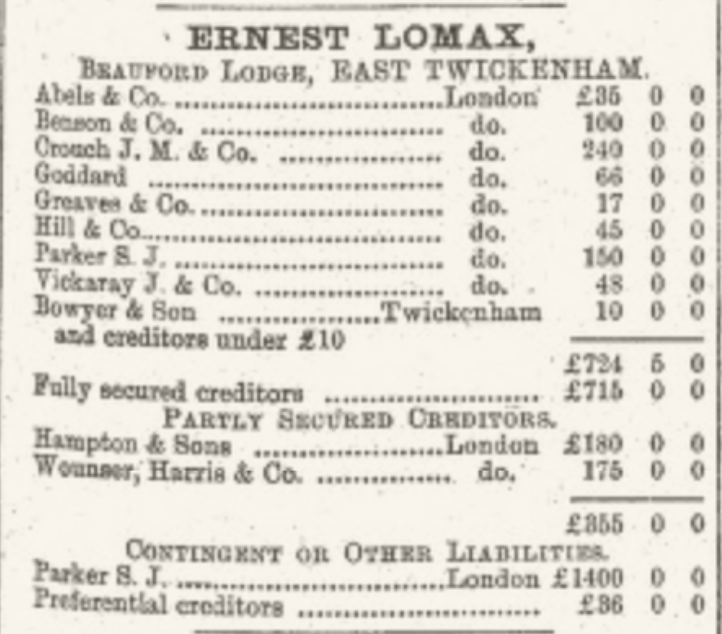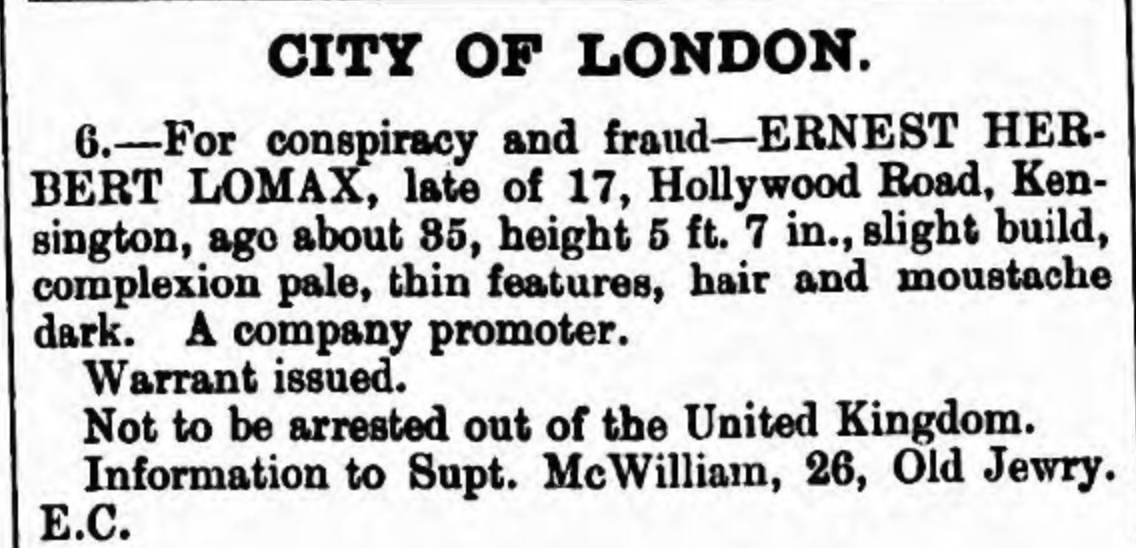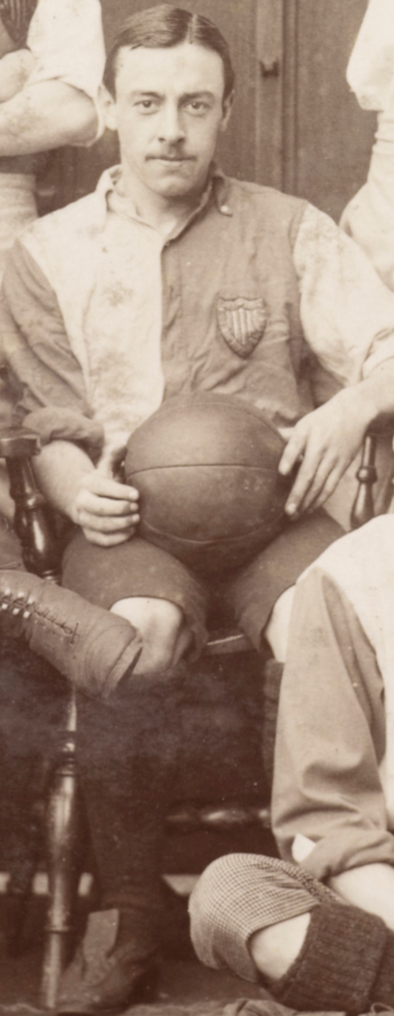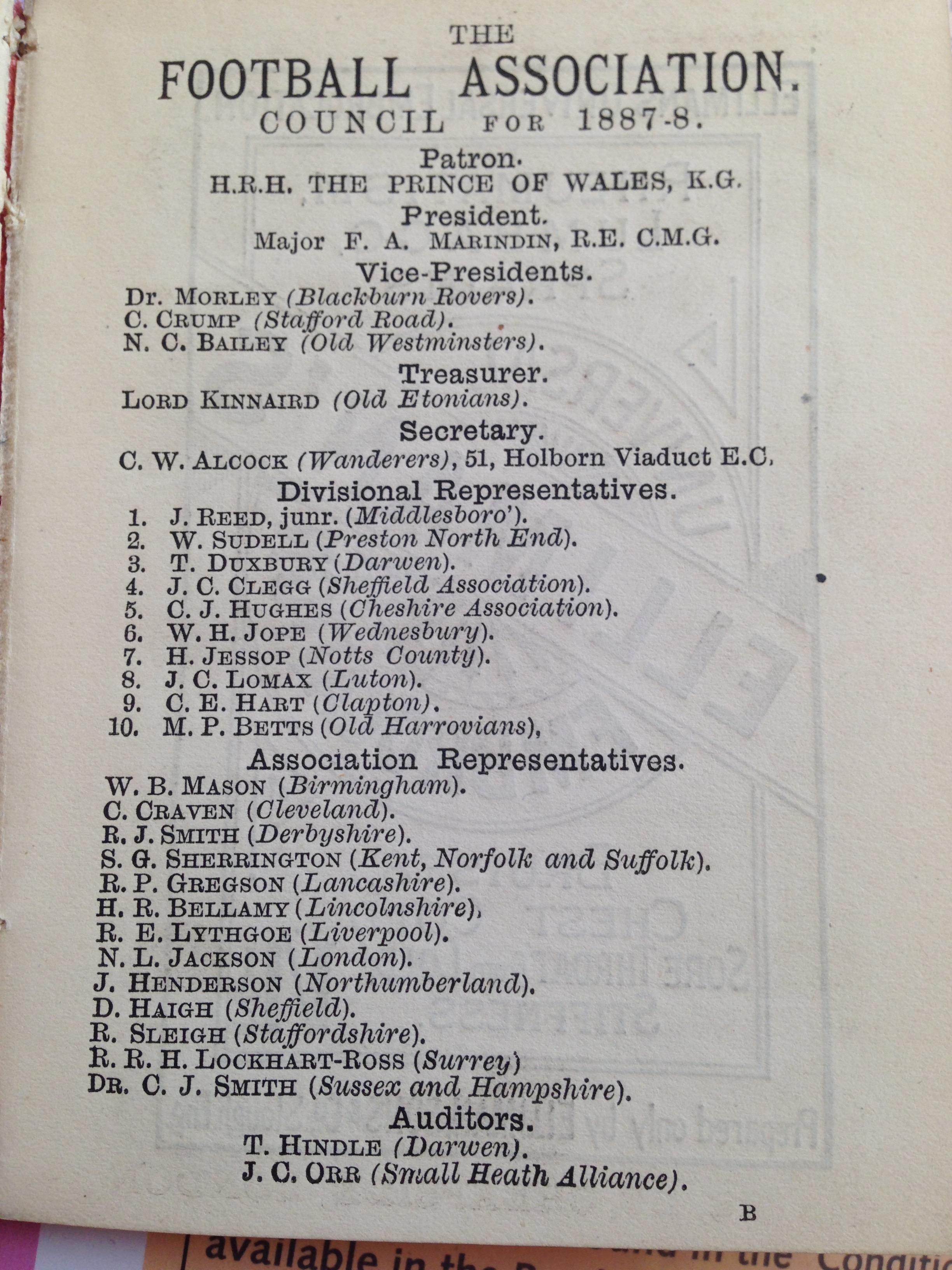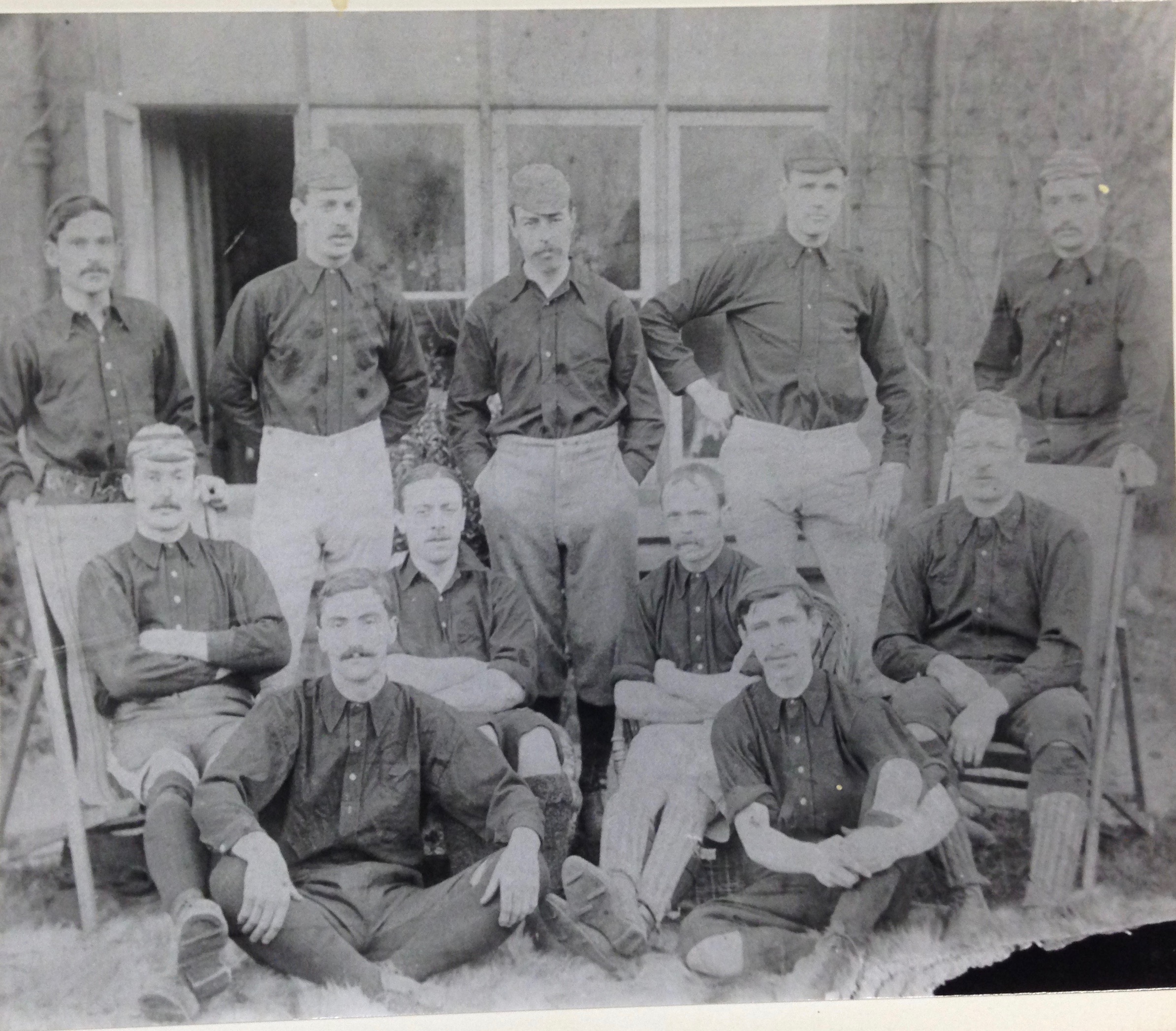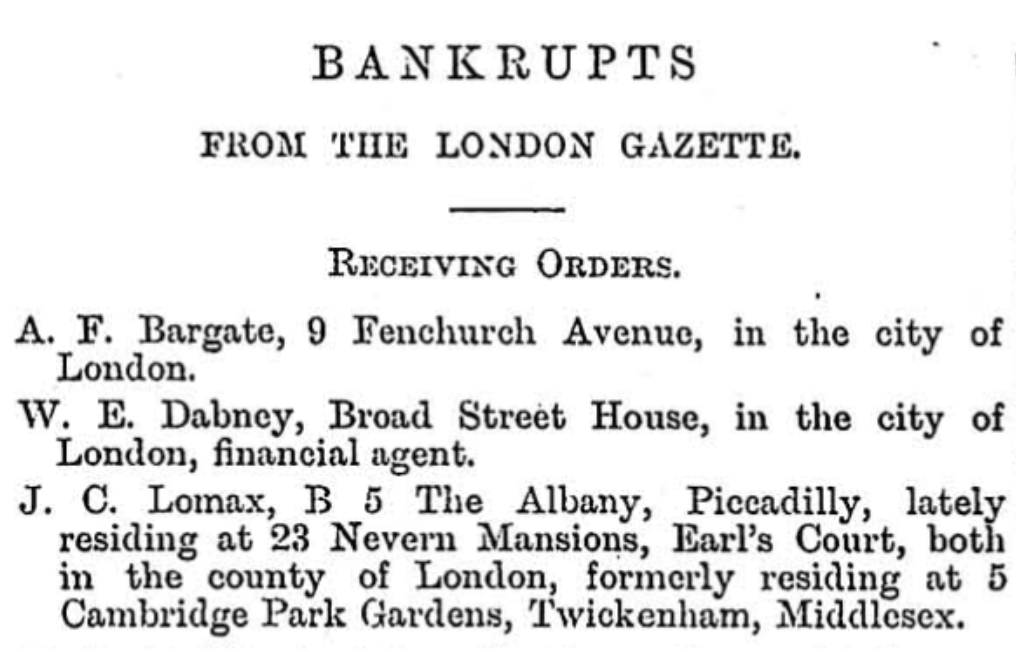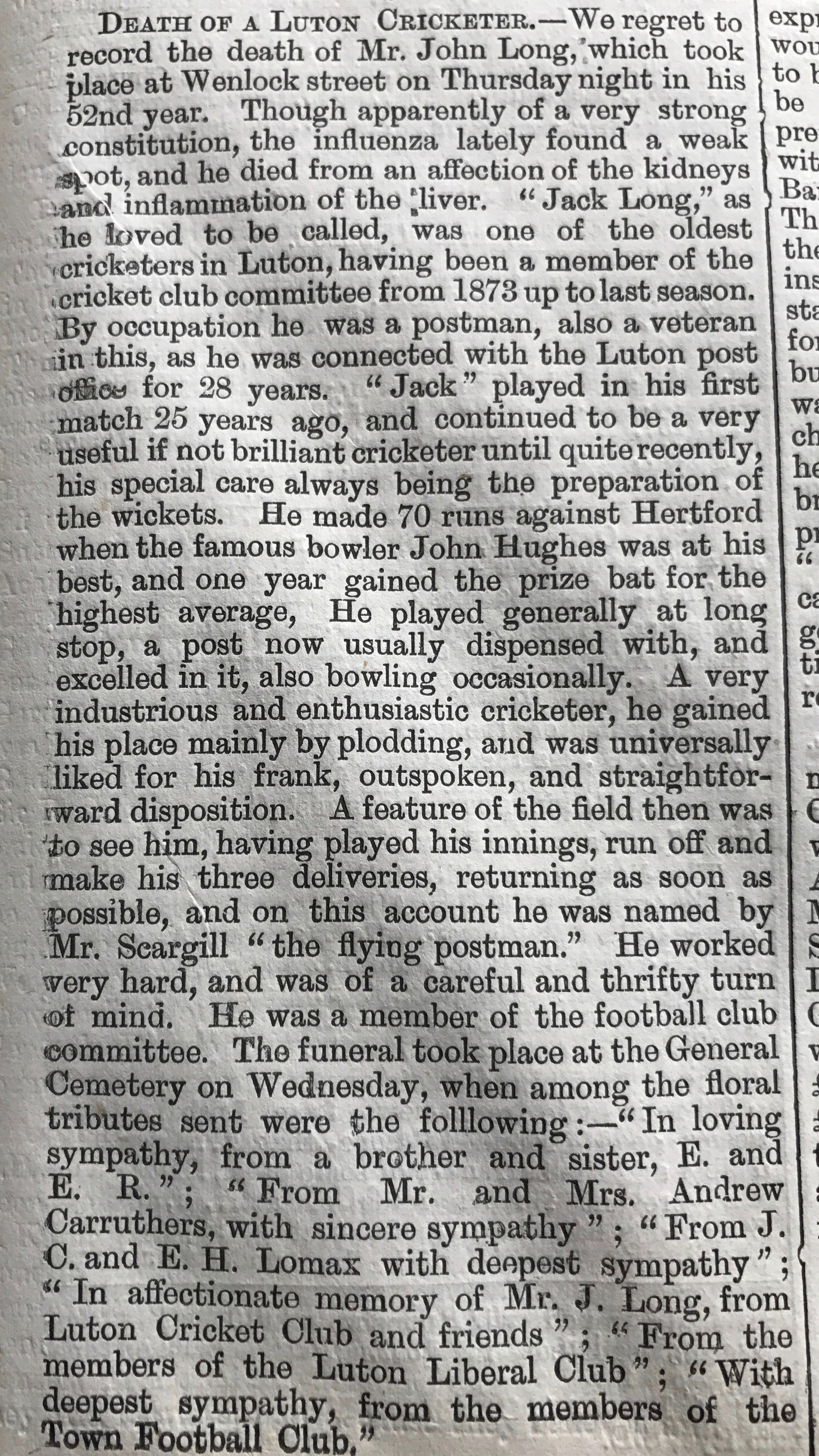James Kemplay
James played 50 times scoring 18 goals.
*********************************************************************************
William Lindsay
Born in Stockton on Tees on the 10th December 1872
Played for Stockton St. John’s, Stockton, Everton, Grimsby Town and Newcastle United before joining the Town for his first spell in 1900. He joined Watford in 1903 but came back to Luton in 1907 and finished his career at Hitchin.
Played 68 times in his first spell and 36 in his second spell scoring just one goal from full back.
Died in Luton 27th February 1933
*****************************************************************************
David Alexander Napier Lomax
D.A.N. Lomax was born on the 28th August 1868 in Bury Lancashire. In 1881 he was a 12 year old boarder at St. John’s College, Luton. He was just 17 years old when he became the first Luton Town player to score a hat trick. He played in many positions in the team and excelled in each. His last game for Luton Town was in an F.A. Cup tie on 17th November 1888. Dan attended Oxford Military College and when he was 18 years old he became a Lieutenant in the 3rd battalion of the Northumberland Fusiliers on 29th December 1886. He was described as a “Gent”. On 2nd December 1888 he was promoted to Second Lieutenant. He became Lieutenant on 19th November 1890 when he transferred to the 41st “Welch” Regiment. The Regiment was initially called the “Royal Invalids” but gave this title up in 1787 and gained 11 battle honours in the War of 1812. It later fought in Burma, the 1st Afghan War and in the Crimea.
He married Emma Annette Morris in 1892. His first son, Cyril Ernest Napier Lomax, was born in the summer of 1893 in King’s Norton. The photo above is of Emma with Cyril. A brother, Gerald David Lomax, was born on 6th January 1895 at Manorbier, Pembrokeshire, where the Regiment was garrisoned.

The above is an extract from the log which details the movements of the 41st Regiment. The first date is the “March” and the second date is the “Arrival.” Note the 23 day march from Pembroke to Plymouth.
The Regiment arived in Plymouth in August 1895 and played it’s first football match on the 5th October, and entered the Devon Senior League and the Devon Senior Cup. D.A.N. was the team captain when in April 1896 his Regiment beat the 2nd Battalion of the 66th (Royal) Berkshire Regiment to win the Devon Senior Cup.
The Regiment finished 5th out of 11 in the League. D.A.N. also represented his regiment at cricket and seemed to have been a decent batsman. The only scorecard I can find shows he was top scorer with 40 against the local public school, the Plymouth and Mannamead College.

D.A.N. was made Adjutant of the 1st battalion of the regiment on 28th December 1898. He wrote the “History of the services of the 41st “Welch” Regiment” which is still available today. It was published on St. David’s Day 1899. He was promoted to Captain on 14th June 1899. However, the regiment’s quiet time on garrison duty was brought to an end as a war had to be won. The Regiment was shipped to Port Elizabeth and the Boer War.
The Regiment was thrust straight into the war against the Boers and the website victorianwars.com gives us the background. –
“In October 1899, the Republics of the Transvaal and the Orange Free State declared war on Great Britain. The subject of the quarrel no longer matters.
At first the war went badly for the British. Ladysmith and Kimberley were besieged and attempts to relieve them failed. By this time the 1st Battalion The Welch Regiment was on its way to South Africa. Lord Roberts had been appointed to the command and the 1st Battalion was to form part of his force. The first object was to relieve Kimberley. Skilful planning and organisation beforehand were the foundations of success in this move.
When all was ready the attack was launched. General John French with his cavalry dashed for Kimberley and relieved it whilst the infantry marched fast to cut off the Boer main force retiring from the siege. Hard marching did it and Cronje, the Boer commander, took up his position at Paardeberg in an entrenched position on the Modder River.
The actual battle was fought on the 18th February 1900, in which the 1st Battalion was heavily engaged and received special mention for a gallant charge. On the 27th February, Cronje with his men surrendered. On March the 7th, the advance was continued on Bloemfontein, the capital of the Orange Free State.
On the 10th March a strong force of Boers barred the way, at Driefontein posted on the heights. The 1st Battalion were ordered to storm the heights, whilst the Yorkshires and the Essex moved round on either flank. The ground was bare, and afforded no cover. The advance was made fifty yards at a time under heavy fire. Two more battalions were thrown into the fight, and eventually the whole line fixed bayonets and charged. The Boers fled to their horses and disappeared, our cavalry failing to round them up. In this action the Battalion lost 140 men, amongst them the Adjutant, Captain DAN Lomax, who had behaved with the greatest gallantry.”
“In his telegraphic dispatch of 11th March, Lord Roberts says ”The brunt of the fight fell on Kelly-Kenny’s division, two battalions of which – the Welsh and the Essex – turned the Boers out of two strong positions at the point of the bayonet”. Various correspondents referred in terms of praise to the work of the Welsh. The Press Association correspondent, in an admirable account wired from the field, after referring several times to the way in which the battalion advanced in face of a heavy fire, – both gun and rifle, – said “Just before dusk the Welsh Regiment gallantly rushed the position at the point of the bayonet, taking a kopje and clearing a portion of the ridge. The scene was witnessed by Lord Roberts through a telescope”. The battalion lost Captain Lomax, Lieutenant Wimberley, and 29 men killed, 5 officers and over 100 men wounded”.
Note – a kopje is a hill. The word kop comes from this. Legend has it that a when standing at the top of the Liverpool terraces, a Boer War veteran said it was so high that it reminded him of standing on the Spion kopje.
D.A.N.’s name is mentioned in despatches by Lord Roberts (dispatches dated 15th March 1900 and 31st March 1900) who adds that “he rendered conspicuously valuable service and had he survived would have brought his name prominently to notice”.
He was heard to shout “Come on the Welch” during the assault in which he died. He embodies the regimental motto “Gwell Angau Na Chywilydd” meaning “Death Rather Than Dishonour.”
I had assumed that as the British held the battlefield they were able to retrieve their fallen comrades and give them a decent burial. However, it appears that D.A.N. and his comrades are buried in a mass grave on or near the battlefield. So there is no gravestone or carefully tended cemetery, which is a great pity. The Boers, however, have their own cemetery and the descendants of the fallen Boers have photographed every grave and put them online.
There is a roll of honour (below) at the Armour Museum, Bloemfontein, Free State. D.A.N. is named at the head of his men.
Luton’s newspapers carried the story.
16th March 1900 – The Bedfordshire Advertiser. “Fallen at the front. Captain D.A.N. Lomax, whose name is among the killed in Lord Roberts’ dispatch of March 11th, will be remembered in Luton as a football player – he and his brothers (C. and E.H. Lomax) being among the first members of the then Amateur Town Club. Captain Lomax was for ten years a pupil of the late Mr Henry Wright, St. John’s College, Luton. He joined the army in 1888 and obtained his captaincy in 1899. The “Times” says : Captain David Alexander Napier Lomax 1st Battalion Welsh Regiment, who is reported to have been killed in the fighting near Driefontein, entered the army from the militia as second lieutenant on November 19, 1890, and captain on June 14 1899. He was born on August 28, 1868.”
23rd March 1900 – The Bedfordshire Advertiser – “A Pathetic Announcement. the following two notices appeared in the “Telegraph” on Monday, the first among the Deaths and the second in the births: “On March 10, killed in action at Driefontein, David Alexander Napier Lomax (Dan), Captain and Adjutant the 1st Battalion the Welsh Regiment (41st), youngest son of the late John Lomax, of Springfield, Bury, and 25, Upper Grosvenor-street, W. aged 31. His life to his country, his soul to God. On March 16, at 54 South-street, Park-lane, W., the wife of the late Captain David Alexander Napier Lomax, Adjutant of the 1st Battalion the Welsh regiment (41st) gave birth to a son.” As we mentioned last week, Captain Lomax was an old pupil of St. John’s College, Luton, under the late Mr H. Wright, and with his two brothers, was very popular as a football player for the Town club in its early days.”
4th May 1900 – The Bedfordshire Advertiser. “The late Captain Lomax. Readers will appreciate the subjoined extract from M.A.P. its subject having been educated in Luton and a prominent football player in the Town team in its early days. :- probably the best-known of the Welsh Officers who have fallen in South Africa was Captain D.A.N. Lomax, the adjutant of the gallant 41st. It is not too much to say that he was far and away the most popular man in the regiment. The officers loved him, the rank and file simply adored him. He was a keen sportsman, and a capital cricketer : he was also captain of the regimental football team when they won the Devon Cup some few years ago. He has left a widow and two bonny little boys to mourn his loss. Posterity will best know him as the historian of the Welsh Regiment. Not only had he a wonderful facile pen, but he had antiquarian gifts, and was never so happy as when burrowing into the records of the past. he had, moreover, the reputation of being the second authority in the kingdom on regimental uniforms and colours. His ponderous volume on the history of the Welsh Regiment was only published a few days before he left for South Africa in October last. None will mourn more than the “Non Coms” of the Welsh Regiment, amongst whom, in consequence of his initials, he was always affectionally known as “Dan”.
The Probate records show his effects were worth £19,279 16s 7d. Typical of the man, he left a carefully constructed will and we will not be surprised to learn that others were at the forefront of his thoughts. He left money to his executors, books to the regiment plus £50 for the purchase of a silver cup as a memorial. He left £20 to the Sergeants’ Shooting Club of the regiment “in the hope that it may encourage them in the pursuit of good marksmanship”. This sounds like a reference to a standing joke. Small donations were also given to The Chelsea Hospital for Women, the Veterans Fund, the Army Temperance Association, the British Home for Incurables and to the Society for Finding Employment for Soldiers of the First Class Army Reserve. His wife and children were left the remainder save for £90.
Llandaff Cathedral (South Glamorgan today) was given several donations including £90 for the erection “of a tablet in his memory to be placed beneath the colours of the 41st Regiment”. The Cathedral had a tablet to the 41st’s fallen of the Crimean War only. D.A.N. recognised this did not include the men from other wars. The inscription on D.A.N.’s tablet reads
“To the Glory of God and sacred to the memory of the Officers, NCO’s and men of the 41st (Welch) Regiment who were killed in action or died of wounds during (1) the campaign in North America 1812-14 (2) the campaign in Burmah 1824-26 (3) the campaign in Afghanistan 1842….. This tablet was erected by bequest of the late David Alexander Napier Lomax, Captain and Adjutant of the 41st whom was killed in action at Driefontein, South Africa on 10th March 1900 as an affectionate memory of deep attachment to his old beloved Regiment.”

Dan’s son, Gerald David Lomax, died of his wounds fighting in his father’s regiment on 11th May 1915 at Ypres and is buried at Estaires Communal Cemetery. He was just 20 years old. The second son, Cyril Ernest Napier Lomax also served in the Welch Regiment and made it to Major-General and died in 1973.
The third son, Victor Alexander John Dan Lomax, born on 16th March 1900, six days after Dan died, is clearly named after his father. The Wrexham Advertiser of 19th May 1900 covered the christening and informs us that;
“Her Majesty the Queen gracefully signified her intention of being godmother, and she was represented by the Hon. Mrs Grant. Her Majesty sent a very handsome two-handled silver bowl, which was inscribed “Victor Alexander John Dan Lomax, from his godmother, Victoria R.I., [Regina Imperatrix] May 10th 1900.”
Victor was commissioned as a pilot officer in the R.A.F. on 29th August 1939. Victor, photographed above in 1960, died in North Tyneside in 1978 aged 78.
Dan’s wife, Emma, was to re-marry just over a year after Dan’s death to become Lady Emma Towle.
The London Daily News of 20th August 1900 said;
“Captain Lomax died of his wounds, or would have been recommended for the Victoria Cross.”
Dan Lomax should be included in every conversation about Luton Town F.C. legends.
My thanks are due to;
Jenny Hocking for the photo of Emma and Victor.
The Regimental Museum of the Royal Welsh, Brecon for D.A.N.’s service dates and photograph.
eggsa.org for the Bosrand roll of honour photograph.
flickhivemind.net for the Llandaff Cathedral memorial photograph.
maltaramc.com for the 41st Movement Book extract.
Roger Walters of “Greens on Screen” for his help on Dan’s time in the South West
************************************************************************
Ernest Herbert Lomax
E.H. was born on 7th October 1866 in Bury, Lancashire. He was 14 years old at the time of the 1881 census and at St. John’s College in Luton. E.H. joined J.C. at Peterhouse, Cambridge University being admitted on the same day, 1st October 1884.
E.H. followed J.C. into the Luton Wanderers team playing at (full) back and especially at half-back. Unlike J.C., he took University seriously and did study for a B.A. Although busy with his studies he played for the Wanderers quite regularly. He supported his brother at the 11th April 1885 meeting at the Town Hall. E.H. seconded the motion put by Gilbert Small to form a Town Club.
When the Secretary of the club, Frank Pitkin, took ill at the start of the first season a crisis loomed. Fortunately for the club E.H. stepped in to act on a temporary basis until Isaac Smith took over a few months later.
He gained a B.A. in late 1887 and was admitted to Inner Temple on 7th November of the same year. He played football for St. John’s College, Luton Wanderers, Luton Excelsior, Peterhouse, Cambridge University (photo left) and Luton Town. Alongside J.C. Lomax he also played for Bedfordshire many times and in various East Midlands Counties Football Association representative games. He paid to be a patron of Luton Town in order to help support the club financially.
He was a tough tackling half back with an eye for a goal. Never afraid to get stuck in, he is mentioned receiving an injury on many occasions. He played in the 1890 Kettering and District Charity Cup final against Grantham. His injury in the replay helped Grantham win the day.
E.H. played his last game for Luton Town on the 4th October 1890 against the 93rd Highlanders in the F.A. Cup. Yet again, E.H. was injured in the match but managed to struggle on until the end for the sake of the team. It may have been due to injury that he ended his football career at the age of just 24.
In the 1891 census he was described on the census as a gentleman living at Springfield House, Cranford lodging with J.C. He is described as “living by his own means”. The fortune that his father left him did not last long as he was made bankrupt with the Receiving Order being made on 9th August 1892 at Brentford County Court. He is described as living at “Beaufort Lodge” in East Twickenham which still stands today and is a substantial building. E.H. bought a string of race horses in 1892, some of them from his old St. John’s College friend, Locke Narburgh. The cost and maintenance of the horses must have drained his resources. It is reasonable to assume that E.H. was heavily involved in gambling and he lost a lot of money very quickly. His creditor’s were set out in the Commercial Gazette of 28th September 1892 (left) with the largest sum of £1,400 being owed to an S. J. Parker. I have only been able to identify a few creditors, John Bowyer of Twickenham, a corn merchant who was owed £10. Hampton and Sons were cabinet makers and antique dealers in Pall Mall East, London who were owed £180. Vickaray and Co of Regent Street were jewellery makers and travel bag manufacturers to Royalty. Benson and Co were watch and clock makers. The contents of his house were sold off in an auction (advert below) which took two days.
With no money E.H. had to work as a solicitor and he helped form a company “The Consolidated Finance and Exploration Company Limited.” They appear to have been asset strippers – buying company’s and selling off the best parts and then winding them up. The company also promoted shares in new companies including a gold and diamond mining company, of which E.H. was a director. If that was not bad enough matters get worse as E.H. attended Mansion House to answer a summons of fraud in October 1897. At the time he was living at Aylburton House, Richmond. This is a well known fraud, involving a piano making company, known as the Brinsmead Swindle and involved over £40,000. It appears concerned the flotation of Thomas Edward Brinsmead and Sons Limited about which E.H.’s company, Consolidated and Exploration Finance, made false statements in the prospectus. You can see E.H.’s name amongst the directors in the advert below. E.H. was granted bail.
The trial was held at the Old Bailey in April 1898 but E.H. did not attend. The jury took less than an hour to find all the defendants guilty.
Brinsmead’s sued E.H. and others in the civil courts. All the chickens now came home to roost at the same time and another fraud case surfaced involving E.H. and others selling the rights to gold and diamond mines, which presumably did not exist. The court was told that,
“Ernest Herbert Lomax left the country for his own good and the country’s own good (laughter)”.
A warrant was issued for his arrest – the following is from the Police Gazette of 18th February 1898;
There we lose track of him, which was, of course, his intention. Although passports were in existence, travellers often only required a ticket to travel around the world. I assume he changed his name but I cannot be certain. There were opportunities to be had in Canada, America, South Africa, Australia; all were young countries and countries who did not know him.
Photograph of E.H. Lomax reproduced by courtesy of the Master and Fellows of Peterhouse’.
**********************************************************************************
John Charles Lomax
J.C. Lomax was born on the 22nd October 1864 at Sale, Cheshire. In 1871 he was living with his wealthy parents, John Lomax senior and Mary Ann Lomax at “Springfield House”, Bury. The family had four servants including one nurse. John senior is described in the census as a retired cotton spinner. As J.C. was named after his father, as is the Victorian tradition, he was known by his middle name, Charlie.
J.C.’s mother died in 1875 aged just 35. His father sold the house and moved to Bayswater, London,. J.C. (photographed left in his Peterhouse kit) and his brothers, E.H. and D.A.N. and his sister Beatrice Eugenie were all sent to boarding school.
The boys were all sent to St. John’s College, Luton and they all appear there on the 1881 census. The college excelled at football and rugby and J.C. played both as well as cricket in the summer. J.C. was noticed by the two major teams in the town, Wanderers and Excelsior. A pacy winger with outstanding dribbling skills, J.C. chose to play for the Wanderers. He was elected onto the board of the regional football association, the East Midlands Counties Football Association (E.M.C.F.A.) which formed in 1884. Under the E.M.C.F.A he represented Bedfordshire on the pitch many times. He met the best players from the region and persuaded many to come and play for Luton Town, such as the Bower brothers from St. Neots and the legendary Arthur H. Taylor of Bedford.
J.C., around five foot tall, formed a partnership on the left wing with the equally diminutive George Deacon. The “little ‘uns” as they were known terrorised many defences and launched Luton Wanderers into the position of premier club in the town. Relations with Luton Excelsior were good and 1883 a combined team beat Newport Pagnell away – a remarkable result. George Deacon later said that this victory gave him the idea of a “Town Club” made up of all the best players. Perhaps because some foresaw the break-up of all other clubs at the expense of a Luton Town Football Club, Deacon’s vision did not materialise smoothly.
After Herbert Spratley and his co-conspirators arranged a secret meeting and changed the name of the Luton Wanderers to Luton Town (see Chapter 5), there were rumours J.C. would leave them. There is one report of a game in which the writer hopes that J.C. will never leave the Wanderers. Fortunately, J.C. did not walk away from the issue but decided to take action. It is clear that J.C., Deacon and many others disapproved of Spratley’s way of forming a Town Club. J.C. was first to speak at the meeting called on 11th April 1885 at Luton Town Hall. His speech was summarised by the Luton Reporter;
“Mr J.C. Lomax was called upon to give his opinion upon the proposed formation of a Town Club, said he was most emphatically in favour of a proposed Luton Town Football club, not, however, for the breaking up of any other club. The reasons he advanced were that the proposed club would give more scope to find out who were really the best players to play in the town matches: it would give them more opportunity of showing what they were as football players; and it would form a good club for the training of young players, who could thus work up to play in the town matches. He could not quite see any objection to the proposal, because it would do away with all that petty feeling which had hitherto existed. Taking all these points into consideration, he might say he was very emphatically in favour of the establishment of a club which could really be called the Luton Town Football Club.”
As J.C. was the first person called upon to speak by the Chairman, we can reasonably assume that he was one of the major instigators of the meeting. They won the day and the Luton Town Football Club was formed (see Chapter 6 for the full story of this meeting). His vision of giving the young players in the town the opportunity of showing what they were as football players was fulfilled as in the first season the club would try out 55 players. The reputation the club has today for giving players a chance and developing them can be directly traced to J.C. Lomax’s vision of 11th April 1885. It was appropriate that J.C. scored the first ever Luton Town goal in October 1885 against Higham Ferrers.
J.C. had gone to study at Peterhouse at Cambridge University on 1st October 1884. However, he was one of those students who used University as a means to play as much sport as possible. He played football and rugby for Peterhouse which impinged on his Luton Town appearances. He also played lawn tennis and cricket in the Summer for Peterhouse, Luton Town and any other team that would invite him. Although in 1886 he said that Luton Town would have first call on his services he did play for St. Albans on a number of occasions at the expense of the Straw Plaiters. He spread himself too thin and failed to turn up for a number of games when picked to play.
He was a quiet, generous man who treated the working class men of the town with the greatest respect, and he received respect in return. It was in his manner not to appeal for fouls, even bad ones against himself. It was a peculiar feature of the Victorian Gentleman that it was bad form to ask for a free kick. The implication was that a gentleman did not need the help of a third party such as the referee or umpire. The Luton Reporter said the following about him in the January 1888 game against Hanover United;
“Several times a foul ought to have been claimed by J.C. Lomax, but his generous disposition forbade him noticing it.”
His unbounded generosity is demonstrated at an F.A. Cup tie at Maidenhead in 1889. Frank Pitkin, the committee member, mentioned to J.C. the benefits of insuring the team against accident on the field. J.C. Lomax immediately gave Pitkin £6 towards the cost of the insurance. The University records show that J.C. left Peterhouse without any qualifications. When E.H. graduated with a B.A. at Christmas 1887, J.C. left too.
Having served on the board of the E.M.C.F.A. the Luton Times reported that on Monday the 26th September 1887;
“at the general meeting of the English Association held in London on Monday, Mr J.C. Lomax, of the Luton Town Club, was elected to represent the division which included Bedfordshire, on the Council of the Association. There were two other gentlemen nominated for the division, viz., Mr F. Sherrington, of Oxford University and Crusader Club, and Mr J.P. Rowlinson of Cambridge University. This is an honour for the Luton Town Club, and no doubt Mr Lomax will prove as of good service on the Council as in the football field”.
This was indeed a great honour and shows that J.C. was a highly respected administrator as well as a footballer. The photo, left, demonstrates that J.C. was moving amongst the most powerful men in the F.A. Note that Lord Kinnaird is the Treasurer – J.C. met him when the Old Etonians (second team) played the Wanderers in 1884.
After a game against Old St. Paul’s on the 14th April 1888 J.C. presided over a smoking concert. The Luton Reporter takes up the story and shows that J.C. could sing as well;
“Luton Town Football Club. – This club brought the seasons play to an end on Saturday, and the opportunity was taken by the committee to invite members to a knife and fork tea at Rudd’s Rooms in Bute Street, to which about 60 responded including the visiting team viz., Old St. Paul’s. The manner in which Mr Rudd catered for the company gave general satisfaction. After tea a very pleasant evening was spent, a smoking concert, under the presidency of Mr J.C. Lomax, being very successful. The following programme was gone through:- Pianoforte solo, Mr Baker; song, “Blind boy at play”, Mr G Smith; song, “Bill of fare”, Mr Wilson, London; song, “Wolf,” Mr Clark; song, “Selected”, Mr Taylor, London; song, “I really can’t keep still”, Mr J.C. Lomax; song, “Wrong Un’s”, Mr H Shane; song, “I went with him”, Mr C Randall; song, “Old Brigade”, Mr Hunt; song, Last, last man”, Mr Nolleth, London; song, Masher king of Piccadilly”, Mr Wilson, London; song, “Veteran”, Mr Bennett; song, “So it was”, Mr Rally; song, “Hear it”, Mr C Randall; song, “Love”, Mr Squires, London; recitation, Mr Lindsay, London; song, “Heats of oak”, Mr G Brown; song, Christening”, Mr Nolleth; song, “I couldn’t”, Mr C Randall; song, Maid of the mill”, Mr G Smith; song, “Near it”, Mr C Randall; song, “Anchored”, Mr Clark; God save the Queen”.
John Lomax senior died on 3rd April 1889 aged just 49 at Bayswater, London. J.C. was an executor of the will which left an estate of £163,257 19s 7d, an absolute fortune. John senior appears to have had a couple of properties in London, one at 25 Upper Grosvenor Street had the Duke of Westminster as one of his near neighbours at number 31. J.C. was made President of the club in his father’s absence at the 1889 Annual General Meeting, a post he held until 1893.
J.C. was made captain and led the team (photograph above is the 1889/90 team) to the final of the Kettering and District Charity Cup final in 1890. This was a prestigious competition which was competed for by the best teams in the region. The first match was drawn one all. About 600 Luton fans travelled to the replay in Kettering. The Luton Reporter recorded that;
“A large number of the travellers displayed in their hats a card bearing in the club colours a portrait of the Captain (Mr J.C. Lomax) and the inspiring words “Play up, Luton.”
The Straw Plaiters were extraordinarily unlucky in the replay. At 0 0 Walter Miller sent in a tremendous shot which the Grantham goalkeeper saved with great difficulty. The referee was said to have indicated that had the Luton men appealed for a goal, he would have allowed it. It is perhaps a pity that J.C. was not more vocal as scoring the first goal may have proved decisive. As it was Humphrey and E.H. Lomax were badly injured but limped on. At 1 0 to Grantham, a second notch, which looked offside, was allowed. Grantham went on to win 3 0. It was a disappointing end to a marvellous cup run but it was a turning point in the club’s history. The committee were galvanised into leaping towards professionalism, the ground was redeveloped and the newspapers in Luton actually turned friendly towards the club and the game of football. The Luton Reporter even introduced a football gossip column later in the year.
J.C. had married Clarice on the 22nd February 1890 but did not tell anyone in Luton until the Annual General Meeting in late August that year. As President of the club, J.C. chaired the meeting and made two speeches. The first was made at the beginning of proceedings. The Luton Reporter said;
“The PRESIDENT then rose to say a few words and was heartily applauded. At the outset he took the opportunity to offer a personal explanation. Most of those present were doubtless at Kettering on occasion of the cup match. There, he said, he made a mistake and a rather serious one. When he had to receive the silver medal he said he wished he had not to appear as the Luton captain. He did not mean that at all. He intended to imply that he regretted that he had to accept the silver medal instead of the gold one (hear hear). He did not feel at all ashamed; indeed he was perhaps as proud as the winning captain. With regard to the report, he believed they had a very successful season, and he thought that thanks were due to all the players, because most of them had played regularly, and it was no use unless a team did play regularly (hear hear). There was one thing he was very sorry about in connection with the Charity Cup matches, and that was the accident to Humphrey, because he played remarkably well in both of them (applause). Respecting the coming season, he hoped that whatever new talent might be in Luton would be brought forward and not remain hid, for he was getting old for one – (laughter) – and some of the others too, but he would play, at any rate, until he was told not to do so. Still he thought that all new players should be tried first in some trial matches and not put into the first or second teams until it was seen what he could do (hear hear). Luton was a growing place, and there were sure to be many good football players in it. Referring to the past season’s average he thought it was not quite so good as the year before; but they had had very hard luck. He hoped that the Club, and in fact all clubs, would again have the assistance of the football loving public during the coming year (applause).”
After the election of the committee had been concluded, J.C. again spoke;
“On this part of the business being reached the PRESIDENT thanked the members of the Club for electing him last year. He had not been able to attend many meetings, as he had a long way to come, but he had done his best in playing (applause). But next year he hoped to play in every match – (applause) – and he added, I may as well tell you now – I meant to have told you for a month or two, but – I am married (great laughter and loud applause). The reason I tell you is that most men’s wives object to their husbands playing football. She won’t let me play cricket, but she will let me play football, so I can play football all through next year (laughter and applause). Mr. Lomax then proposed that Mr Cyril Flower M.P., be President for the ensuing year.
Mr I. Smith, the Secretary, said he had an amendment to that proposal. Mr. Lomax had done very well in the past and he did not think they should change their President. He had pleasure in proposing that their worthy President be re-elected (applause).
Mr. Steabben seconded, saying it would be difficult to find a better man for the office.
The motion was put and agreed amid cheers, “one clap more” being given for Mrs Lomax.
The PRESIDENT said he was very much obliged to them for re-electing him, and he assured them that he try to do all he could for the Club.”
When the accounts were read out to the meeting by the Secretary it was shown that J.C. had donated £5 and also subscribed two guineas as a Patron of the club. As the club made a profit of less than £3, his contribution was vital.
J.C. remained captain in the 1890/91 season but his appearances were more sporadic. His brother, E.H. played his last reported game for the Straw Plaiters in November 1890. J.C. played rarely after the new year and did not attend the 1891 Annual General Meeting. He lost the captaincy in September 1891 when Arthur H. Taylor was made permanent captain. Besides being distracted by marriage, he had a long way to come to matches as the 1890 Kelley’s directory finds him living at “Springfield”, Cranford, Middlesex with his wife and servant. The 1891 census says Clarice was born in San Francisco. She is described as a young and pretty dancer and actress. We do not know how they met. A London Newspaper later reported that there had been a brief courtship and the wedding took place at a “fashionable West-end church and many persons of a high degree assembled”.
At the time they met, according to newspaper reports, J.C. was worth £40,000. He gave half to Clarice together with £4,000 “pin money.” We find a few traces of them as J.C. travels to New York with her in 1892. Clarice and J.C. advertise in a newspaper for a maid in June of 1892 and have servants at their address at 5 Cambridge Park Gardens in Twickenham. At the same time it is recorded in the newspaper that Clarice had made some investments.
Far from being married in a “fashionable West-end church and many persons of a high degree assembled,” their marriage certificate shows that J.C. married Clarice Tuson on the 22nd February 1890 at the Register Office, St. Giles, London. On the certificate, both he and his father are described as “Gentlemen.” J.C. is confirmed as living at “Springfield,” Cranford Middlesex. Clarice is stated to be 21 years old, a spinster but there is no occupation for her. She was living at 1 Duke Street, Bloomsbury at the time of the marriage which is the same address as one of the witnesses, Frederick Doley. It appears to have been a multi-occupancy house, as it is today. Her father was Henry William Tuson and he is described as a “Gentleman.” There is no Clarice Tuson on any records I can find. There is a Clara Tuson the daughter of a Henry William Tuson – he was a printer and they lived in Lambeth in 1881. She was born in the City of London, not San Francisco. The other witness to the wedding was a Florence Harrington. There are a few people by this name and all were servants in London.
It appears that Clarice manipulated J.C.’s laid back and generous nature as there is evidence that she lost money in investments in companies that went bust. There is also evidence that J.C. also lost money in a Zambesi mining company. Clarice lied about where she was born in an apparent attempt to glamourise herself. She had no occupation when they married so it looks like J.C. gave her help in her wish to become an actress and dancer. Her father was a printer yet later a “Gentleman” so it may be that J.C.’s money enabled him to retire early.
Meanwhile in Luton, the stalwart Luton Town cricketer, former Wanderers and Luton Town committee member, John Long died in the Summer of 1892. J.C. attended the funeral as a friend and President of the club. He laid a wreath in the club colours at the Rothesay Road Cemetery. His visit spurred a brief revival with the club at the beginning of the 1892/93 season. He played centre forward in September against the City Ramblers. He was said to be a little out of form but helped the team to a two nil victory. He played much better in a 4 1 win over West Herts and made several “dodging runs” and came within inches of scoring. J.C.’s last game for the club came on Saturday 15th October 1892 in the defeat at home to the Royal Arsenal. He had more pressing issues as his personal life was falling apart.
J.C was made bankrupt, the Receiving Order being made on 13th September 1893. At the time of his bankruptcy his address is described as B 5 The Albany Piccadilly lately residing at 23 Nevern Mansions, Earl’s Court. The former address is one of the best addresses in London and some apartments may have been owned by a former member of his old college, Peterhouse. Nevern Mansions and the area were new and parts were still being constructed.
Clarice died in 1894 in Islington. The newspapers of the time reveal a very sad story. Clarice had left J.C. for a man named Norton. She became very ill and in order to get her admitted to the local infirmary, she insisted that Norton represent himself as her husband. She was admitted on 4th November in the latter stages of consumption, or tuberculosis as it is known today. She died three days later and is described on her death certificate as Clarice Norton. Mr Norton then confessed to what had occurred and he was prosecuted. Subsequently J.C. went to the infirmary, and said that be was the husband of the deceased woman, who had left him some time previously and gone to live with Norton.
From The Times – 29th November 1894 – a summary follows;
“Mr. Ricketts, solicitor, prosecuted Norton for making a false statement and Mr. Cowdell defended. Evidence was given to the effect that defendant obtained an order for the removal of a woman, whom he represented to be his wife, to the infirmary, she being in the last stages of consumption. She was admitted on November 1, and died three days afterwards, the death certificate being made out in the name of Clarice Norton. Subsequently a Mr. Lomax came to the infirmary, and said that be was the husband of the deceased woman, who had left him some time previously and gone to live with Norton. Mr. Cowdell said Mr. Lomax was a man of considerable means, and when he married had a fortune of £40,000. His wife was an actress and dancer, and, owing to her extravagance, the greater part of the money was squandered. The parties then separated, and the wife went to live with the present defendant, Norton. She became very ill, and it was owing to her strong request that Norton represented himself as her husband, in order to get her admitted to the infirmary. She wished her husband to be kept in ignorance of the fact. After her death Norton went to the Guardian and told them the full particulars of the case. The magistrate said it was a serious offence, but, taking all the circumstances of the case into consideration, he would be satisfied if defendant paid 2s. and 22s. costs.”
Clarice’s death certificate shows that she died on the 4th November 1894 at Holborn Infirmary aged just 24. She is described as Clarice Norton. Her occupation is described as “actress” of 2 Old North Street, Red Lion Square, Holborn. The cause of death is given as “Bronchitis” and the informant is the superintendent at the Infirmary. There is a note at the end of the certificate which reads as follows; –
“In Number 213 col 3 [the column which has her surname] for Norton read Lomax corrected on 8th November 1894 by me C.R. Butcher, Registrar on production of a Statutory declaration made by John Charles Lomax and Frederick Doley.”
After spending all that money and helping to make J.C. bankrupt, Clarice died in the workhouse infirmary.
There are few details of the rest of his life. There are unconfirmed sightings of him in my research but the only firm fact is that in 1933 he was living in the Green Hills district of Albany, Eastern Cape, South Africa. He worked as a “Call Secretary” at Prince Alfred’s Infirmary, Grahamstown, Eastern Cape. On 4th May 1933 he contracted influenza, lobar pneumonia and went into a coma. John Charles Lomax passed away on the 8th May 1933 at the Settler’s Hospital, Grahamstown and is buried in the New Cemetery. We are not helped in our investigations by the fact that South Africa compile statistics from census records then throw them away.
His Death Notice shows his occupation as “Civil Service Pensioner” at the time of his death, that he was a widower and his wife died in England. It also shows that he had no immoveable property, did not leave a will and his estate did not exceed £300. His entire belongings were auctioned to pay various costs of his final days. These consisted of a travelling case, attache case, writing case and “odds and ends”. At the time of his death he was earning £1 a week from his hospital duties, £1 11s 8d from his pension and he had just £14 cash to his name. There was a deficit on his estate so presumably he received a simple internment.
The hospital “Form of Information of a death” shows that he was initially described as being “single.” However, this is crossed out and in its place is “widower.” Forty years after Clarice left him, J.C. had an attachment to her until the end.
There lies John Charles Lomax, a small man but a giant in the history of Luton Town Football Club. He is buried far from home, presumably in a paupers grave. His contribution, along with his brothers, to football in the town is immeasurable. His talent undoubted. A gentleman and a gentle man.
Thanks to;
Philip Pattenden, Peterhouse, Cambridge University
Photograph of J.C. reproduced by courtesy of the Master and Fellows of Peterhouse.
Western Cape Archives and Records Office, Western Cape Government, South Africa
Cherie’ Roux and Jason Frowde for obtaining J.C.’s South African records.
*******************************************************************************
John Long
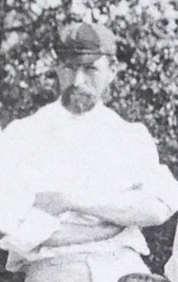 John Long was born in Luton in 1840. The 1841 census shows he lived with his parents in “Donkey Hall” – the original name for High Town. In 1891 he lived with his wife Jane at 24 Wenlock Street.
John Long was born in Luton in 1840. The 1841 census shows he lived with his parents in “Donkey Hall” – the original name for High Town. In 1891 he lived with his wife Jane at 24 Wenlock Street.
He is best known for the part he played in the 11th April 1885 meeting the Town Hall. Herbert Spratley had held a secret meeting of the Wanderers in January and changed the club’s name to “Luton Town”. John was a member of the Wanderers club and met a committee member that night. The following is an account of John’s speech on 11th April 1885;
“Mr John Long said that with regard to the meeting in High Town when the present town club was formed, he had been a member of the Wanderers or the Town Club since its formation, and as soon as he heard of the movement he inquired what business at the meeting was to be, and was distinctly told by one of the Wanderers’ Committee men that the business was not to be divulged by any of the Committee. He did not know what business was coming on, and consequently, did not attend the High Town meeting. Having expressed his wish for the improvement of football, he said the idea of forming a really representative Town Club was first mooted to him by a man who was a member of Luton Town Cricket Club, and was a prominent football player – Mr Deacon – who said “What a good club we could have if we could amalgamate”. He had tried what he could to produce a friendly feeling in the matter and might say that the movement originated with Messrs Lomax and Deacon. He should feel pleased if he could see football improve in the town, and thought that if the best team was put into the field that there were not many towns to beat them.”
His speech exposed Spratley’s secret meeting and sealed the formation of the Luton Town Football Club. He served on the Luton Town committee from 1885 -1887 and from 1889 until just before his death in 1892. He was greatly mourned as per the attached report by the Luton Times of 6th May 1892.


